Google Announces Stadia: A Game Streaming Service
by Ian Cutress on March 19, 2019 1:12 PM EST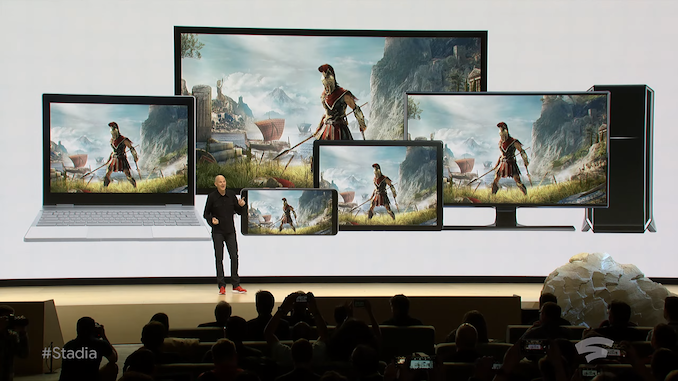
Today at GDC, Google announced its new video game streaming service. The new service will be called Stadia. This builds on the information earlier this year that AMD was powering Project Stream (as was then called) with Radeon Pro GPUs, and now Google is confirming the project is a primary partner using AMD’s next generation GPUs. (Edit: AMD reached out to confirm that their press release only mentioned GPUs.)
Stadia is being advertised as the central community for gamers, creators, and developers. The idea is that people can play a wide array of games regardless of the hardware at hand. Back in October, Google debuted the technology showcasing a top-end AAA gaming title running at 60 FPS. Google wants a single place where gamers and YouTube creators can get together – no current gaming platform, according to Google, does this.
Ultimately Google wants to stream straight to the Google browser. Google worked with leading publishers and developers to help build the system infrastructure. Google is one of a few companies with enough content delivery networks around the world to ensure that frame rates are kept high with super low latency.
Users will be able to watch a video about a game, and instantly hit ‘Play Now’ and start playing the game in under five seconds without any download and lag. The idea is that a single code base can be enjoyed at any stream. At launch, desktop, laptop, TV, tablets, and phones will be supported. With Stadia, the datacenter is platform. No hardware acceleration is required on the device. The experience can be transferred between devices, such as chromebook to smartphone.
One of the highlights of Google’s demonstration of Stadia was the platform working on Google-enabled TVs.
The platform allows users to have any USB connected controller, or mouse and keyboard. Google will also be releasing its own Stadia Controller, available in three colors – white, black, and light blue. The controller connects via Wi-Fi straight into the cloud, and also which device is being run (it’s unclear how this works).
The controller has two new buttons. The first allows saving and sharing the experience out to YouTube. The second is Google Assistant, using the integrated microphone in the controller. This allows game developers to integrate Google Assistant into their games. It also allows users to ask Google when they need help in a game - and the assistant will look for a guide to help.
Stadia uses the same datacenter infrastructure already in place at Google. There are 7500+ edge nodes allows for compute resources being closer to players for lower latency. Custom designed, purpose built hardware powers the experience. Interconnected racks have sufficient compute and memory for the most demanding games. The technology has been in development inside Google for years.
At launch, resolutions will be supported up to 4K 60 fps with HDR and surround sound. Future plans for up to 8K streaming at 120 fps are planned. The platform has been built to scale to support this. While playing, the stream is duplicated in 4K for direct upload – you get rendering quality video rather than what you capture locally.
The platform is instance based, so Google can scale when needed. Game developers no longer have to worry about building to a specific hardware performance – the datacenter can scale as required.
Sadia is powered by a custom AMD GPU with 10 TFLOPS of power, with a custom CPU with AVX2 support. Combined they create a single instance per person. Uses Linux and Vulkan, with full Unreal and Unity support. Havok engine support as well. Tool companies are onboard.
At a high level, the specifications for the GPU are almost a shoe-in for AMD's Radeon Vega 56, right down to the number of CUs and compute throughput. So while not confirmed, it's very likely that Google is using some kind of Vega 10 card; probably a variant of the Radeon Instinct MI25.
However it's notable (and unusual) that Google is only announcing their partner for the GPU and not the CPU. With AMD capable of delivering solid products in both categories, one would consider them a shoe-in for the CPU as well since they're already providing the GPU. However Google's announcement took special care not to announce the CPU partner, and even AMD emailed us that they could only confirm the use of AMD GPUs. So whether Google's CPU vendor is Intel or AMD remains to be seen. There are good arguments for each based on the vague specifications, though with AVX 2 support listed, if it is AMD then that would mean that Google has gotten their hands on some early Zen 2 CPUs.
One of the first games supported will be Doom Eternal from id Software, which will support 4K with HDR at 60 fps. Every user will get a single GPU with no other users.
UL Benchmarks (3DMark) has been working with Google to help benchmark the systems and measure the power of the infrastructure. Developers if required can use multiple GPUs, it appears.
Multiplayer is also supported, at least between different Stadia players. Distributed physics becomes possible, which means up to 1000 players in Battle Royale titles. There’s also the advantage, according to Google, of getting around hackers and cheaters.
Developers can support multi-platform multiplayer, and transfer save files between platforms. Game developers have already been working on MP demos with destructive environments using real-time rigid body physics, allowing for perfect synchronization.
Google also points out that split-screen gaming has not been a priority recently because of rendering two scenes at once. With Stadia, that problem disappears, as each player will be powered by a separate instance, reviving the idea of local co-op and squad based gaming. This also allows for multiple cameras for a single player to navigate a single map, for better tactics in certain types of games. Google says that this ability allows developers to create new types of games.
Built on Google’s platform, Stadia will also support machine learning. For developers that want to take advantage, they can incorporate Google and third-party libraries to help improve games over time and enhance the experience both on a per-user level and on a local/global scale.
The other focus on Stadia is the interaction with YouTube. Google points out that gaming has been a fundamental part of YouTube since its exception, and it is Google’s goal to help creators interact with (and monetize) their audience. The idea is that creators can directly livestream from Stadia, as well as play with creators through Stadia. ‘Crowd Play’ will allow users to play directly into the server instance with the creator – it acts like a lobby, so players will sit in line to play with their favorite creator. For example, the NBA2K above shows 'join this game (3rd in line)'.
Google states that any link from any location can act as a launch point for a title. This means that developers do not have to be limited to a single game store – games can be launched from almost anywhere, as long as the user is in an up to date Chrome browser. Google is also set to put extensive parental controls into the mix.
Google will be creating an entity called ‘Stadia Games and Entertainment’, headed up by Jade Raymond, enabling first party studios to use Stadia. Other partner studios will also work through the new division as outreach in order to enable game development on Stadia.
Developers who want to create for Stadia should go to stadia.dev to sign up for tools and resources. Stadia Partners for distributers. Stadia.com will be the hub for gamers.
Stadia will launch in 2019, in the US, Canada, UK, and most of Europe. No word on pricing yet, but Google will be announcing more in the Summer.


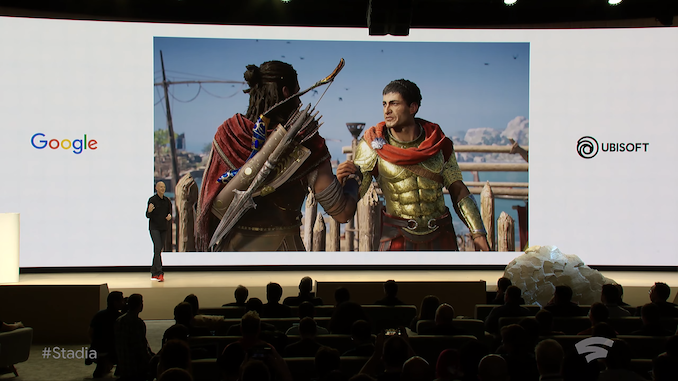
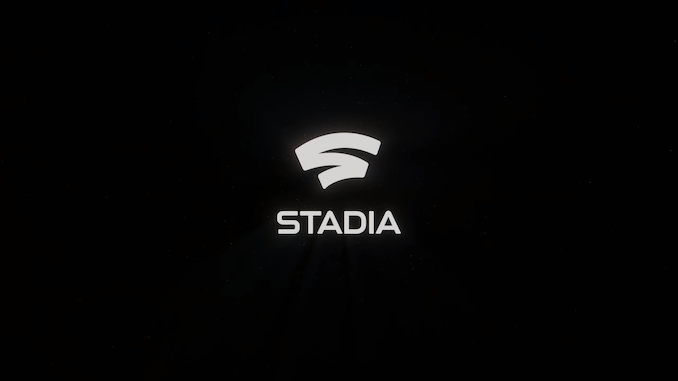
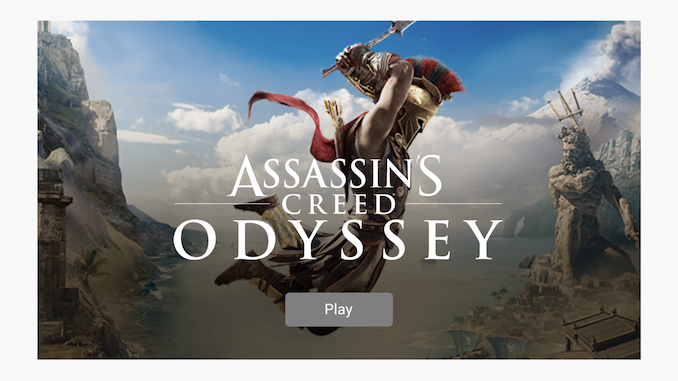
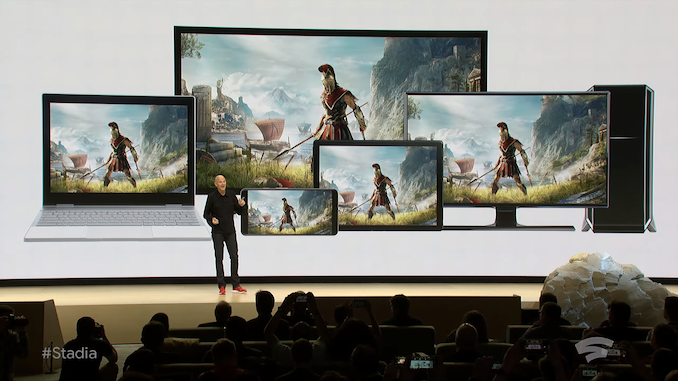
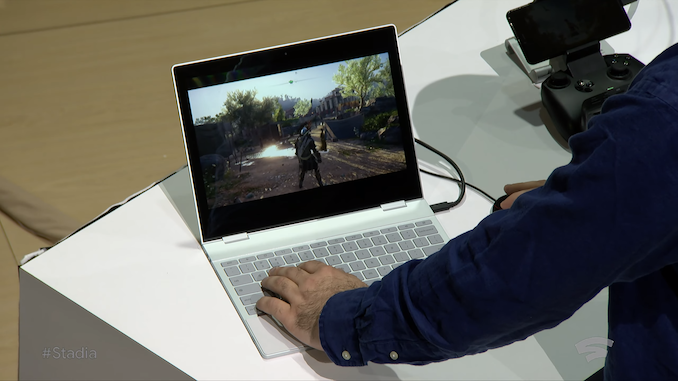
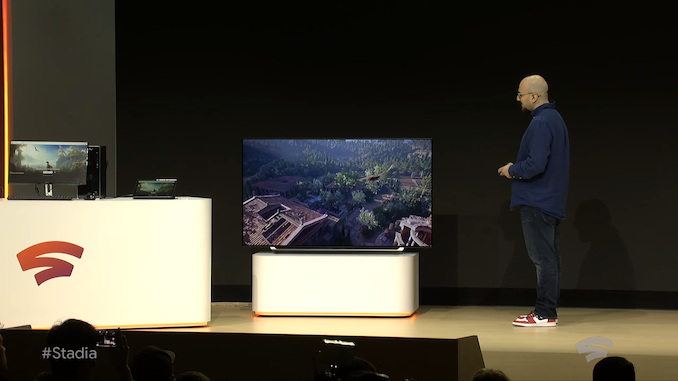
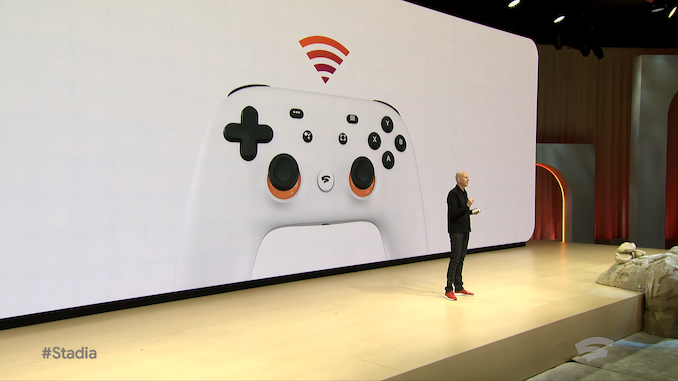
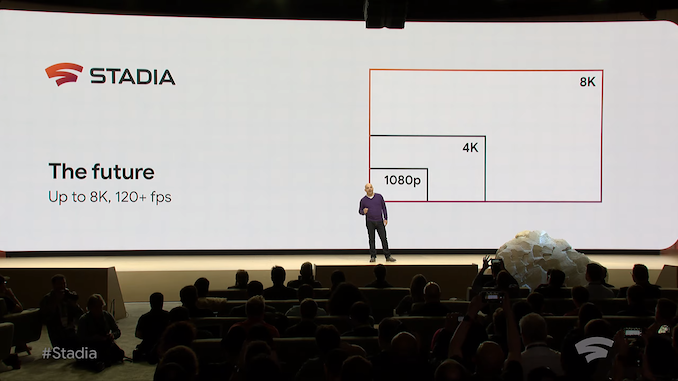
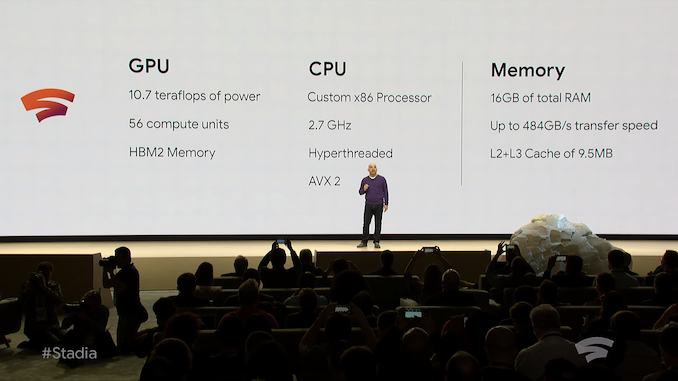
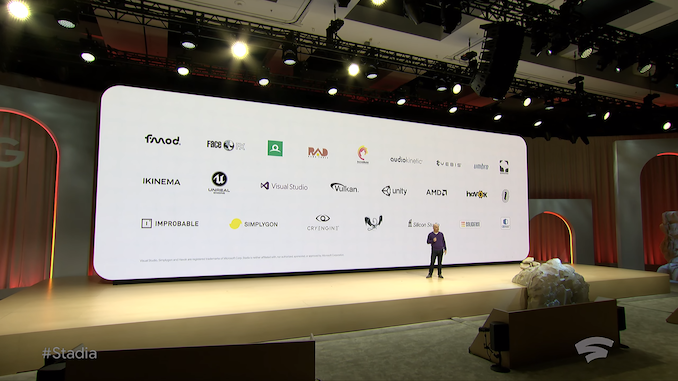
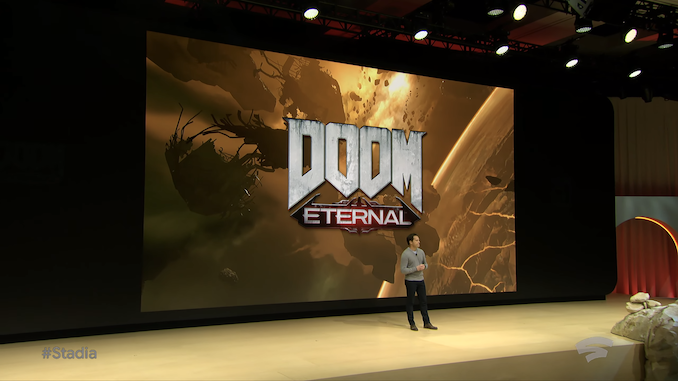

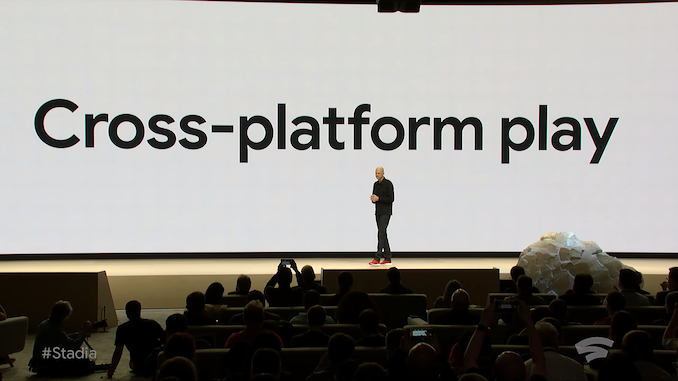
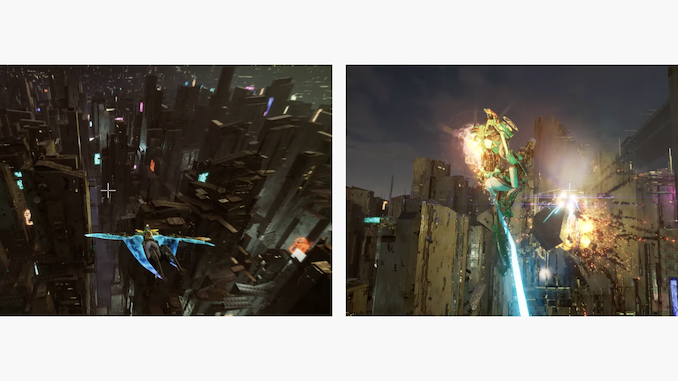

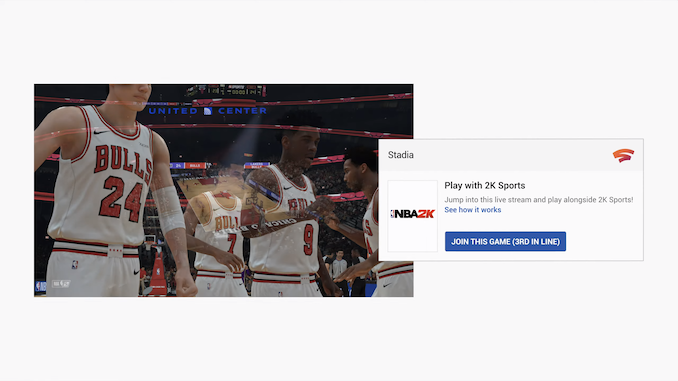
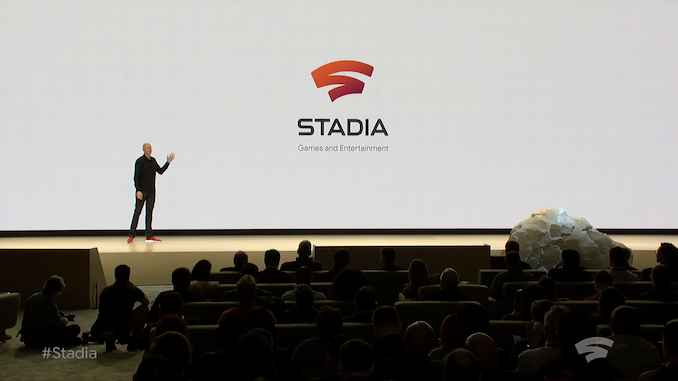








144 Comments
View All Comments
Faciet - Saturday, November 23, 2019 - link
Génial! Le streaming gagne de plus en plus en popularité chez les joueurs. Je préfère jouer dans les casinos en ligne à l'adresse https://fr.casinoonlineschweiz24.com/casino-en-lig... Il y a beaucoup de machines à sous avec lesquelles je peux gagner de l'argent et il me semble que c'est une bonne raison de diffuserzmatt - Wednesday, March 20, 2019 - link
Someone was able to determine that the demo they showed had on average 200ms of latency. That's during a keynote speech in what is likely about as best case a scenario as Google could put together, (I doubt they would have allowed anything to potentially ruin their presentation afterall). So in the real world it will be far worse than that. 200ms is worse ping than I currently get on conventional online games. It's probably ok for slow paced or turn based games but anything real time is going to suffer and if its competitive and online then it will be unplayable. I can't see anyone having a good experience in a competitive FPS with this service.emilemil1 - Wednesday, March 20, 2019 - link
Yeah, I'd say get it down to a maximum of 50ms and I'd consider it for certain games. The one thing that bothers me the most would be delays in camera movement,0ldman79 - Wednesday, March 20, 2019 - link
Linus Tech Tips did a review/preview of a streaming game service where the latency was around 13ms running locally and 22ms running remotely.This was over fiber and the service was located in the same city I believe.
I've done quite a bit of playing with Steam and PS4 streaming. The latency added by the streaming itself isn't too bad, 1ms for the controls and less than 6ms for the video.
That works fine until I play Street Fighter or Gran Turismo, then it is painfully obvious. Even Batman Arkham series runs fine over it. I set up an EOIP bridge to my office over my wireless Internet service, three miles away as the crow flies, roughly ten miles of wireless links, three hops, total input latency was around 15ms and video was around 30ms but it was very playable. Again, Street Fighter would come apart, but Batman, Serious Sam HD, less timing intensive games ran fine, almost indistinguishable from local play.
zmatt - Friday, March 22, 2019 - link
Yeah and in most places fiber is not available. It's just now starting to be available in my city and only in limited neighborhoods.To get a realistic idea of how it will work you have to consider what most people will have. I average around 100ms in normal online games. However having random spikes go much higher isn't uncommon and sometimes its just completely shits the bed.
Most people also aren't on the best optimized LANs with wired connections and QoS. They are usually on a crappy chinese router provided by the ISP with stock settings operating on WiFi in an area with crowded spectrum. I've seen some places where WiFi was provided sub dial up performance in the same room as the AP because there were 20 other APs within range broadcasting on the same channel.
The home network aspect can be fixed a bit with just some basic knowledge, but don't expect most users to have it. And it can be entirely eliminated with some knowledge and spending a bit of money, but again don't expect that to be the norm. The ISP issue however is often not up to the end user and completely out of their hands.
Games that are slow paced, strategy games like CIV or have a degree of slop in the controls, action games like your Arkhams of the world should be fine on a decent home network with a decent ISP. Games that require any level of precision; racers, FPS, fighting games will be unplayable. And like I said, the expectation should be a poorly designed network with an unreliable connection.
Gastec - Saturday, March 30, 2019 - link
All the same. If you are in Portugal and the server is in the Netherlands or Germany or God forbid in the USA you will get a high latency that's directly proportional to the cable length + all the nodes in between. Not even counting the latency from your own hardware. Stadia is not for "competitive" multiplayer shooters, it's for single player mostly. And useless if it doesn't allow importing of game saves. But 200ms latency is too much even in single player games, unless it's not directly perceived by the end user.anonomouse - Tuesday, March 19, 2019 - link
The specs of that custom GPU sure look a lot like the specs of a Vega 56, although there's some stuff here that seems pretty weird. AVX2 "support" is potentially because Ryzen supports AVX2, just not at a higher throughput than AVX. However, the Memory section of that slide is the really weird part, because either they're being disingenuous by listing the GPU's HBM2 bandwidth there while implying that the CPU sees that bandwidth, or they're implying that the CPU and GPU both share a total of 16GB HBM2, which would suddenly make this a very very custom solution. My money is on the first hypothesis, because it's not even clear that this CPU is necessarily even an AMD part. The L2+L3 number is hard to reach with any common configuration of Zen cores that I can think of, but is perhaps more reasonable from a Skylake config.formulaLS - Tuesday, March 19, 2019 - link
Google's list of partners doesn't have Intel listed but has AMD listed. So I would expect AMD CPU and GPU.DanNeely - Tuesday, March 19, 2019 - link
The CPU and GPU sharing HBM2 would be a logical evolution of AMD's existing console platform, just updated for newer parts. It'd be custom work, but of a sort AMDs done before, and could potentially also feed into XBox/Playstation v.next work.BigMamaInHouse - Tuesday, March 19, 2019 - link
Looks like AMD Custom APU with 16GB HBM2 on-board shared between CPU/GPU!.